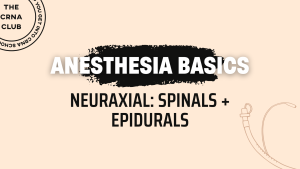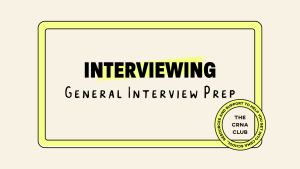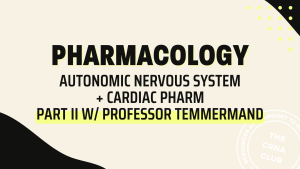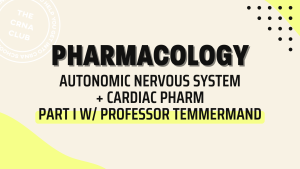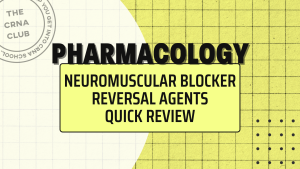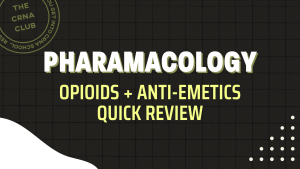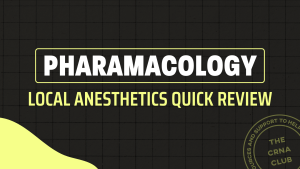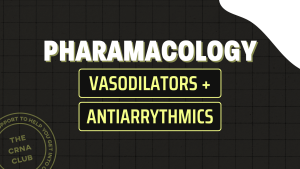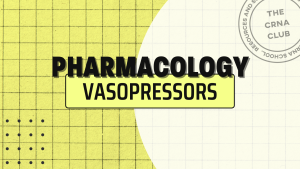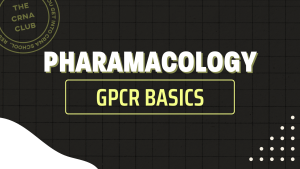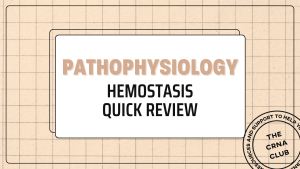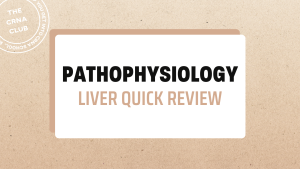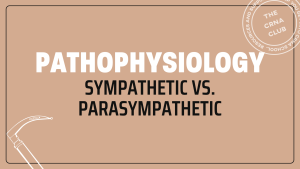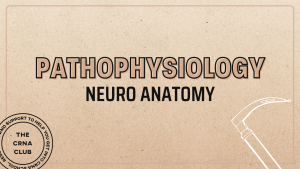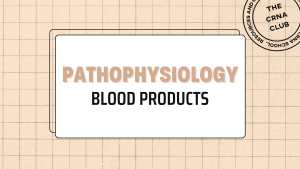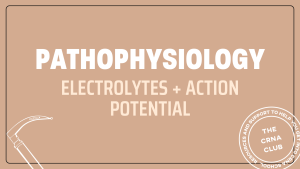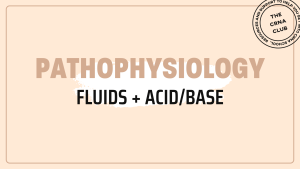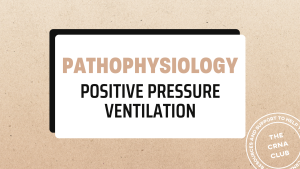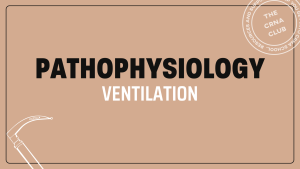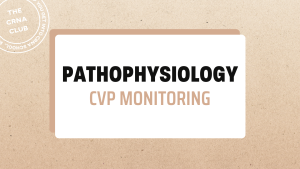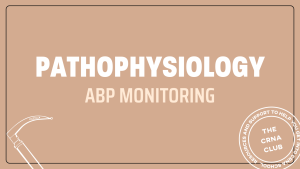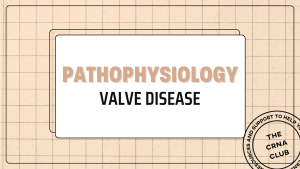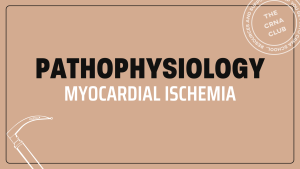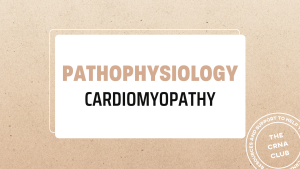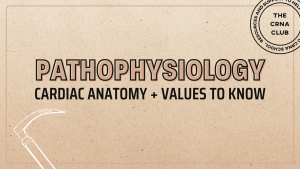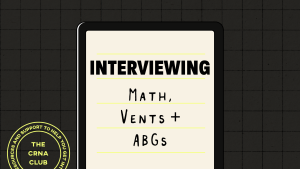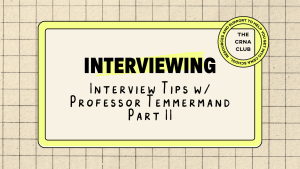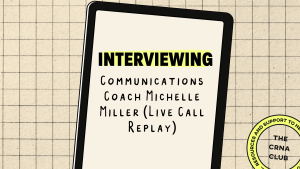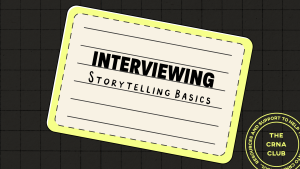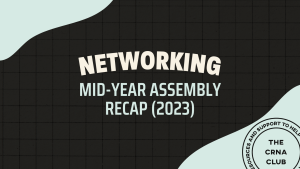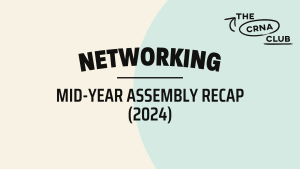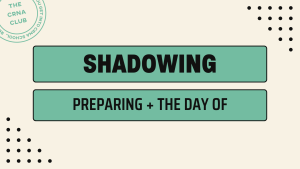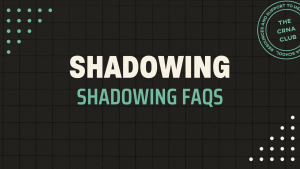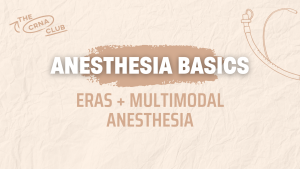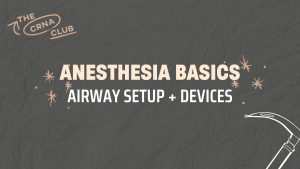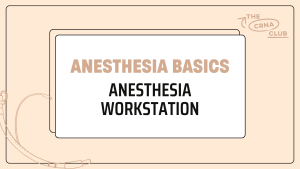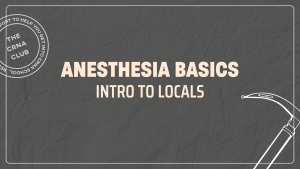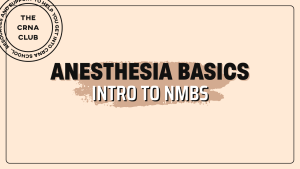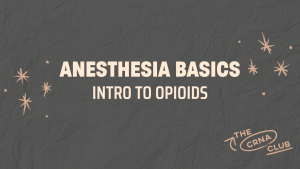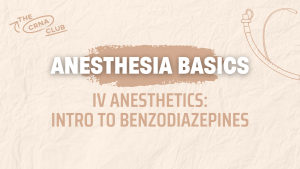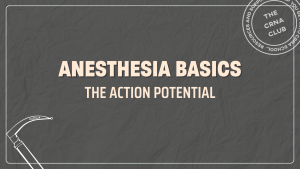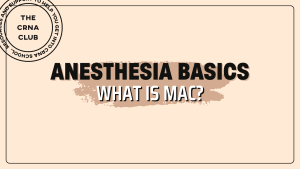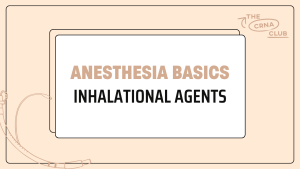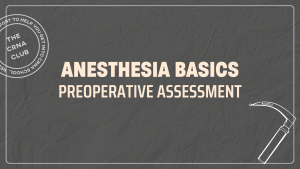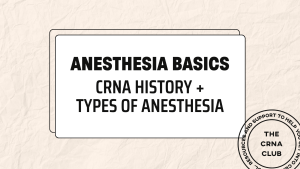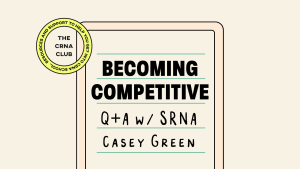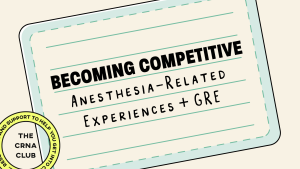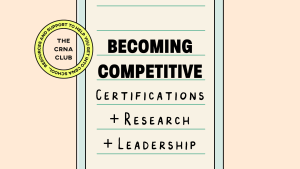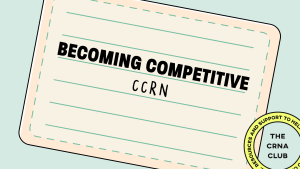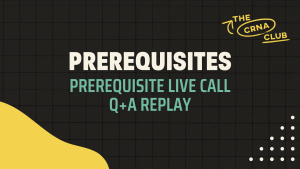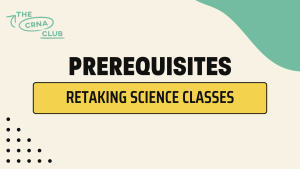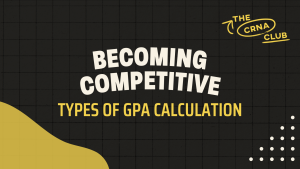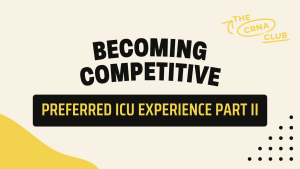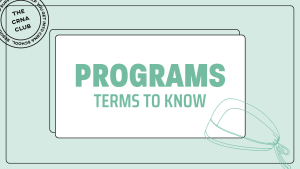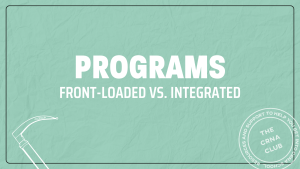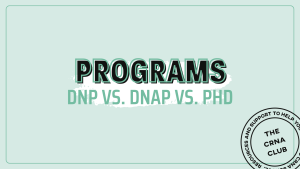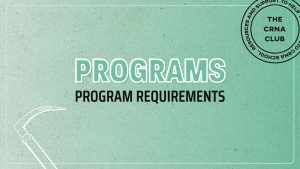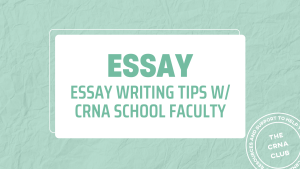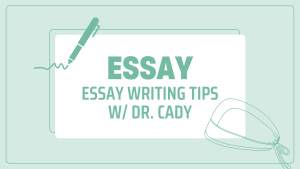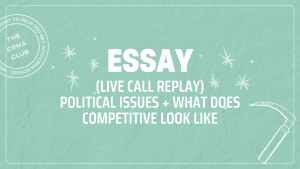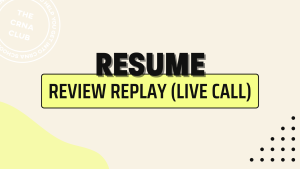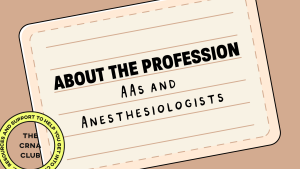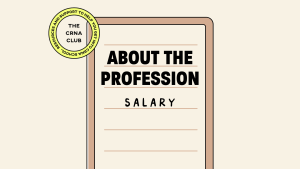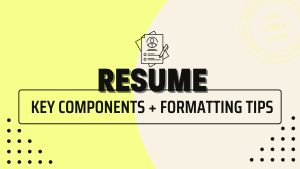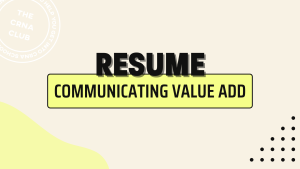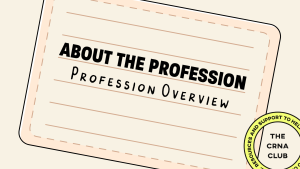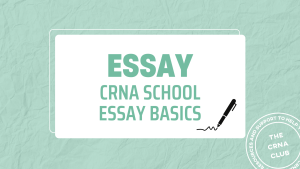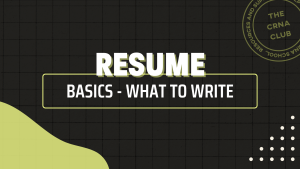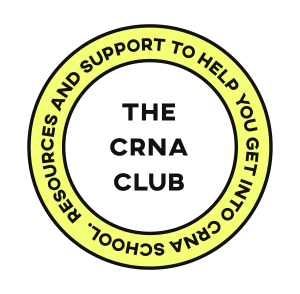CRNA
LIBRARY
CRNA LEARNING LIBRARY
Categories
GENERAL INTERVIEW PREP
In this lesson, we go over the basics of interview prep, what to prepare for if you have a virtual or in person interview.
AUTONOMIC NERVOUS SYSTEM + CARDIAC PHARM PART II W/ PROFESSOR TEMMERMAND
This is Part II of a two part lecture series given by Professor Temmermand on the Autonomic Nervous System and pharmacology. Definitely a must-watch!
AUTONOMIC NERVOUS SYSTEM + CARDIAC PHARM PART I W/ PROFESSOR TEMMERMAND
Professor Temmermand gives an EXCELLENT two part pharmacology lecture. If you need to quickly prepare for your interviews and don’t have much time, definitely watch Part I and Part II of this series.
NEUROMUSCULAR BLOCKER REVERSAL AGENTS QUICK REVIEW
We have to reverse the muscle relaxants we give, and we do that in several ways. Watch this lesson to understand what we’re talking about when we say we “reverse” our patients.
OPIOIDS + ANTI-EMETICS QUICK REVIEW
Watch this lesson to briefly review how opioids work, where, and some side effects. Plus, we go over antiemetics like Zofran.
NEUROMUSCULAR BLOCKERS QUICK REVIEW
You may give muscle relaxants in the ICU, and it’s a drug class that we give every day in the OR. While you give it likely for vent synchrony (and so do we at times), we also give it for other reasons. Watch this lesson to learn more.
LOCAL ANESTHETICS QUICK REVIEW
Did you know there is something called Local Anesthetic Toxicity? Yep – this is something that we fear as anesthesia providers. Fortunately, we know how to use local anesthetics safely, and we know how to treat LAST if it occurs. Watch this short lesson to understand how Lidocaine works and it’s side effects.
INTRODUCTION TO INDUCTION AGENTS
We don’t expect you to understand all of this in depth, but it’s great for you to know how Propofol, Etomidate, Ketamine and Precedex work!
BENZODIAZEPINES QUICK REVIEW
Certainly you’ve given Midazolam probably almost every shift – but can you explain how it works and what it’s 5 uses are? Watch this to brush up on one of the most common medications you probably give, and something we give every day in the OR.
BETA BLOCKERS, NSAIDS, ANTICOAGULANTS
In this lesson we briefly go over beta blockers, NSAIDs and anticoagulants. We discuss where these drugs work at the cellular level, and lightly touch on the coagulation cascade.
VASODILATORS + ANTIARRYTHMICS
Vasodilators and antiarrhythmics have unique mechanisms of action that can be a bit tricky for people. If someone asks you the difference between Nitroglycerin and Nitroprusside, would you get it right?
VASOPRESSORS
You’ll want to really understand as much as you can about the drugs you use on a daily basis in the ICU. We also use vasopressors in the OR, and we need to know that you understand the mechanism of action, dose, side effects and indications of the ones you use in the ICU.
GPCR BASICS
G-Protein Coupled Receptors are really a graduate level topic, but you may be familiar with the term if you are studying how many of the drugs you use on a daily basis in the ICU work!
HEMOSTASIS QUICK REVIEW
Let’s go over primary vs. secondary hemostasis, formation of the platelet plug, where some common drugs work like Plavix and NSAIDs, and of course DIC and a brief refresher of the clotting cascade.
LIVER QUICK REVIEW
In this lesson we discuss basic liver anatomy, the functions of the liver, its role in drug metabolism, and symptoms of cirrhosis.
RENAL QUICK REVIEW
Time to discuss the functions of the kidney, its role in acid base balance, and some different diuretics and where they work. Plus, BUN vs. creatinine, ADH, aldosterone, ANP, the RAAS system, and acute vs. chronic renal failure.
SYMPATHETIC VS. PARASYMPATHETIC
This is a brief overview of the sympathetic vs. parasympathetic system, let’s review the cholinergic crisis and anticholinergic syndrome.
NEURO ANATOMY
Time to review the cranial nerves! Plus cerebral perfusion, the Circle of Willis, and some spinal cord blood flow anatomy.
BLOOD PRODUCTS
In this refresher on blood products, we briefly review ABO compatibility, platelets, FFP and cryoprecipitate.
ELECTROLYTES + ACTION POTENTIAL
Let’s review the role of calcium, potassium, magnesium, and sodium in regards to the action potential, and also the treatment of hyperkalemia.
FLUIDS + ACID/BASE
Let’s discuss the difference between LR and NS, causes of acidosis and alkalosis, and the kidney’s role in our acid – base balance.
POSITIVE PRESSURE VENTILATION
This overview of basic positive pressure ventilation covers CPAP vs. BIPAP, physiologic effects of PPV, and some common vent settings that you probably use everyday.
VENTILATION
Let’s revisit the oxyhemoglobin dissociation curve, basic lung capacities and values, the capnography waveform, and ventilatory disorders like V:Q mismatch.
PA CATHETERS + SPO2
What indications of PA catheter placement, what information can it tell you, the normal waveform and what are causes of increased and decreased PAOP?
CVP MONITORING
This is a must know! What are indications for CVC placement, complications of placement, and where does it sit? Let’s also review some causes of increased and decreased CVP, and what the A wave, C wave and X descent are.
ABP MONITORING
Refresh your memory on the components of the arterial BP waveform, what causes changes in your ABP waveform, and complications of arterial pressure monitoring.
VALVE DISEASE
Let’s discuss aortic regurgitation, aortic stenosis, mitral regurgitation, and mitral stenosis. We go over symptoms, treatment, and hemodynamic goals.
MYOCARDIAL ISCHEMIA
What are some causes of myocardial ischemia, risk factors, and treatment? Let’s also discuss EKG changes associated with acute ischemia and leads to watch.
CARDIOMYOPATHY
In this lesson we discuss dilated cardiomyopathy and hypertrophic cardiomyopathy, the characteristics, goals and treatments.
HEMODYNAMICS
A broad category, but in this video we go over some basics like the baroreceptor reflex, systole and diastole, and the ventricular action potential.
CARDIAC ANATOMY + VALUES TO KNOW
Let’s review blood flow, normal pressures in each chamber of the heart, SV, LVEDP, CO and other key values you should know like perfusion pressure and MAP calculations.
MATH, VENTS + ABGS
In this lesson, Mitch, our SRNA contributor, goes over anesthesia (and ICU) math, vent settings, and how to interpret ABGS. Common things you’ll get asked about in your interview.
INTERVIEW TIPS W/ PROFESSOR TEMMERMAND PART II
This is Part II of Interview Tips with Professor Temmermand. She has taught for multiple CRNA programs and has interviewed many students over the years – this is a must watch!
COMMUNICATIONS COACH MICHELLE MILLER (LIVE CALL REPLAY)
Michelle Miller is an expert Communications Coach and gives tips on how to appear and sound confident, keep the nerves at bay, and deliver your message clearly and concisely when you are interviewing.
STORYTELLING BASICS
In this video, we discuss how to tell a story during your interview that doesn’t leave the interviewers mind wandering, or wishing you’d wrap it up. Telling a story to get your point across takes strategy, and can be extremely powerful when done correctly.
MID-YEAR ASSEMBLY RECAP (2023)
In this live call replay, an SRNA who attended the 2023 Mid Year Assembly gives an excellent recap on hot topics and issues facing our profession, plus he gives us his insider experience on what it was like to attend for the first time. RNs have attended this, so watch this if you’re interested in going and networking!
MID-YEAR ASSEMBLY RECAP (2024)
The Mid Year Assembly is one of our national AANA meetings. Each year it’s held in Washington, D.C. and is a political advocacy event. Watch this to learn some of the hot topics currently facing our profession, and what we are lobbying for across the nation (hint hint – great essay content!). One of our SRNA contributors attended and gave his live recap!
PREPARING + THE DAY OF
There are definitely certain things to do and not do in the OR. There are also some things you should be prepared for before you walk into your shadow experience, especially if this is the only one you’ll get! Watch this for day of tips and do’s and don’ts.
SHADOWING FAQS
Your shadow day is far from a passive experience. You should be prepared with a list of questions, things you want to learn about from the CRNA and things you want clarity on (whether that’s program types, roles/responsibilities of the CRNA etc). Don’t miss this valuable opportunity to gain valuable insight by being unprepared.
ERAS + MULTIMODAL ANESTHESIA
You might have heard the term ERAS before. There is a big push to decrease narcotic usage and get patients out of the hospital quicker. This is also a hot topic in the anesthesia world that many people are doing DNP projects on. Watch this so you understand the basics when you go and shadow an ERAS case!
AIRWAY SETUP + DEVICES
When you walk into an OR, you’ll see an airway setup. The CRNA will always have some supplies out, this varies depending on what type of anesthetic is being delivered. Some of the equipment you’ll be familiar with, but some might be new. Watch this video to learn more!
ANESTHESIA WORKSTATION
Walking into your shadow day you will be enthralled with the anesthesia machine – it’s a key piece of equipment that we spend lots of time learning to use. Watch this lesson to understand the basics so you can formulate some thoughtful questions to ask, and impress!
INTRO TO LOCALS
Local anesthetics are something we use in multiple ways in anesthesia. Not only do we give it IV, we give it in our nerve blocks and epidurals and spinals. This lesson is an introduction to how we use them in the anesthesia world, and some things you need to know about how you use it in the ICU.
INTRO TO NMBS
In this lesson we go over neuromuscular blockers, or paralytics. We discuss the difference between depolarizing vs. non-depolarizing. If you’re going to into your shadow day, this is a must watch!
INTRO TO NON-BARBITUATES
You may have never heard the term “non-barbituates” before, but I’m sure you’ve heard of Propofol! Let’s talk about Propofol, where it works, and how it works.
INTRO TO OPIOIDS
In this short video, we introduce you to opioids, where they work, what their mechanism of action is, and some adverse effects of Mu and Kappa activation.
IV ANESTHETICS: INTRO TO BENZODIAZEPINES
In this video, we briefly go over the GABA receptor, what drugs work here, and what happens when the receptor is activated.
THE ACTION POTENTIAL
In this micro lesson, we’re refreshing your memory on the action potential. Why? Because a lot of our drugs work here! Review the action potential basics and you’ll be ready to move on to the other lessons.
WHAT IS MAC?
There are a few different ways we use the term MAC – one for billing, and one in regards to a depth of anesthesia. Confusing – I know. In this lesson we’ll talk about MAC in regards to anesthetic depth, and how we know our patients are really asleep!
INHALATIONAL AGENTS
How do we keep patients asleep? Well, one way is with our inhalational agents or anesthetic gasses. You’ll learn ALL about these gasses and their properties in school, but in this introduction video we go over what you need to know going into your shadow days.
PREOPERATIVE ASSESSMENT
A big part of what we do as anesthesia providers starts with a preoperative assessment. In the preoperative area, you’ll see CRNAs ask specific questions, and do specific assessments – watch this lesson if you’re going into your shadow experience or just want to know a bit more about what happens in preop in regards to the CRNA’s role.
CRNA HISTORY + TYPES OF ANESTHESIA
In this lesson we go over how the CRNA profession came to be, and the basics of understanding anesthesia – the different types. There’s general anesthesia, monitored anesthesia care (MAC), regional anesthesia, and neuraxial anesthesia – it’s a lot but you’ll be able to do it all!
Q+A W/ SRNA CASEY GREEN
Casey Green is an incredible SRNA who really exemplifies true leadership and involvement in her profession. This Q+A session is loaded with tips, insight, and application advice.
ANESTHESIA-RELATED EXPERIENCES + GRE
This is an increasingly important area of your application to develop – anesthesia-related experiences. This is often something that I see accepted applicants put effort into developing. Watch this lesson to understand what we mean.
CERTIFICATIONS + RESEARCH + LEADERSHIP
It’s all about being well-rounded. It’s not just about high acuity experience, or a high GPA, it’s about the big picture. Who are you as an applicant beyond your GPA or ICU experience? Are you a leader, go-getter, overachiever? Watch this lesson to see how you can get there!
CCRN
The CCRN (or a certification in general) is pretty much a requirement (even if it’s not “technically” required). This lesson discusses study materials, a study plan, and our recommended resources.
PREREQUISITE LIVE CALL Q+A REPLAY
In this live call replay we answer some frequently asked questions about retaking courses. If you have a question about retaking a class, it’s likely that we’ve covered it here!
RETAKING SCIENCE CLASSES
The reality is, many people retake classes for multiple reasons, maybe they did poorly in undergrad, or never took a required prerequisite. Watch this to learn more!
REFERENCES BASICS
Asking for references can be daunting and overwhelming, especially if you are applying to many programs. In this lesson, learn what makes a “good” reference, and what things they should be able to speak to.
TYPES OF GPA CALCULATION
If you had no idea that CRNA programs calculate multiple types of GPAs, and that it could play into your application strategy, this is a must watch. Every school is going to calculate your GPA differently, but it’s important to know what questions to ask when calculating your GPA and figuring out what classes to retake.
PREFERRED ICU EXPERIENCE PART II
This is Part II of “Preferred ICU Experience” – while every program can be different in what critical care experience they accept, many have specific preferences for a reason. Watch this to find out what ICU experience will set you up to apply for the majority of programs.
PREFERRED ICU EXPERIENCE PART I
Many people ask which ICU is best for CRNA school, in this lesson we break down the differences between ICUs, and what really matters for your CRNA school experience and application. (Part I)
Q+A W/ FACULTY MEMBER PROFESSOR TEMMERMAND
This is a must-listen live call Q+A replay with Professor Temmermand who is a CRNA faculty member who serves on multiple national committees, speaker, and educator.
TERMS TO KNOW
What’s attrition rate and why does it matter? In this lesson we go over terms to understand when applying to CRNA school – it can be a whole different language!
FRONT-LOADED VS. INTEGRATED
While every graduate, whether they go to a front-loaded or integrated program, comes out with a competent CRNA, the route to get there is a little different. While you’ll adjust to either, it’s best to understand the pros and cons of integrated vs. front-loaded programs.
DNP VS. DNAP VS. PHD
Oftentimes people wonder if they should apply to a program that offers a DNP or DNAP, and what’s the difference? There are a few nuances you should know to ensure you’re not limiting yourself.
PROGRAM REQUIREMENTS
Every program has unique requirements, and there are some specific things you’ll want to know when sorting through each program’s website and requirements list. Watch this video to get a grasp on what you need to know.
TYPES OF LOANS
There are many ways that people pay for CRNA schools, and the majority take out loans. Watch this lesson to grasp the basics on federal loans vs. private, and how to best set yourself up for success.
WHY CRNA? W/ DR. CHARNELLE LEWIS (LIVE CALL REPLAY)
Guest expert and CRNA Dr. Charnelle Lewis (You may find her content under “Nurse Nelle”) discusses how to tell your unique story and pull out your own, distinct “why”. This can be a difficult question to answer, but it doesn’t have to be!
ALL ABOUT THE DNP PROJECT + IDEAS W/ FACULTY MEMBER PROFESSOR TEMMERMAND
In your essay or interview, you might be asked to discuss what you would like to study for your DNP project. While you are not married to this topic, it’s a good idea to have a somewhat educated answer – watch this to learn more about the DNP project, some hot topics, and ideas for your research.
MOST COMMON ESSAY PROMPTS (REPLAY SACHI)
In this live call replay, we discuss how to address the most common essay prompts that most schools ask such as “Why do you want to become a CRNA?” and “What are your short term and long term goals?”
ESSAY WRITING TIPS W/ CRNA SCHOOL FACULTY
Professor Temmermand has taught for multiple CRNA programs and is an advisor to our CRNA Club students. She is well-known and respected in the CRNA community. She has ready many admissions essays and mentored many on their way to CRNA school acceptance. This is a must watch!
ESSAY WRITING TIPS W/ DR. CADY
Dr. Cady has helped many of our students write effective and quality essays over the past few years. While not a CRNA, she has assisted many applicants get accepted to top programs across the country. She is an academic, developmental editor who specializes in admissions essays – she’s got excellent advice!
(LIVE CALL REPLAY) POLITICAL ISSUES + WHAT DOES COMPETITIVE LOOK LIKE
There are political issues that you’d benefit from understanding that are unique to the CRNA profession. These issues will come up at State Meetings, National Meetings and also are great talking points for your essay or interview. The CRNA world is unique, and getting a grasp on why advocacy is so important to us will help make you a competitive applicant.
RESUME REVIEW REPLAY (LIVE CALL)
This is a recording of a live call that we did where we went over everyone’s resumes and gave critiques. While we didn’t show everyone’s CVs on screen for privacy, this lesson is worth a listen to as you’ll be able to pick up on common themes + areas of improvement.
AAS AND ANESTHESIOLOGISTS
A big part of what makes a competitive applicant is someone who is invested in leadership and advocacy. Furthermore, someone who is even-keeled and has great people skills – watch this lesson to learn why!
SALARY
Curious what CRNAs make? Wondering if you’ll get the ROI on missing out on 3 years of income while getting thousands of dollars in debt? You’re not alone.
KEY COMPONENTS + FORMATTING TIPS
Let’s discuss the key features of your resume, the content that you must include, and how to format your resume/CV so that it is skimmable, readable and crisp. The attention is in the details!
COMMUNICATING VALUE ADD
In this video, we discuss how to effectively communicate your value-add on your resume in a unique way, how to use the psychology of words, and how to ensure your descriptors fully showcase your skills and abilities.
PROFESSION OVERVIEW
What makes the CRNA profession different from AAs? Than anesthesiologists? What the political issues we face, and why does it matter to you as an applicant? This is foundational but a must-watch.
CRNA SCHOOL ESSAY BASICS
In this video, we discuss the basics of writing your CRNA school essay or personal statement, when to start, do’s and don’ts, formatting, things to include and not include. We also go over short term vs. long term goals and other common prompts.
RESUME BASICS – WHAT TO WRITE
In this video, we discuss the basics of writing your resume/CV, such as how to write your credentials, key components/headers, when to start, and do’s and don’ts.

